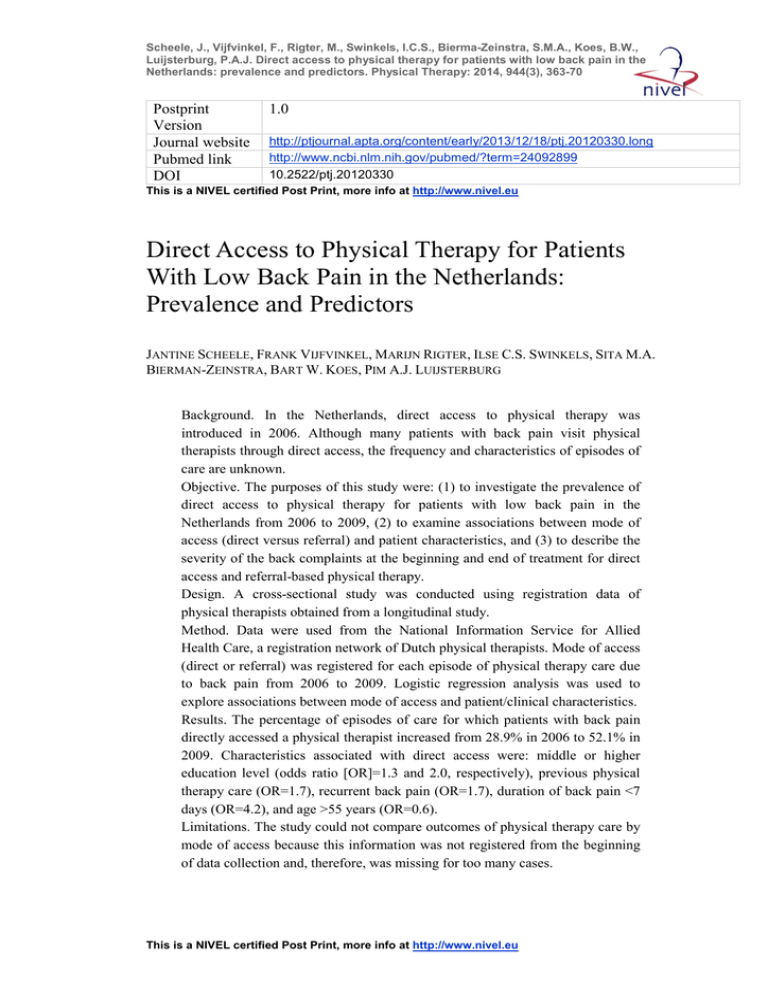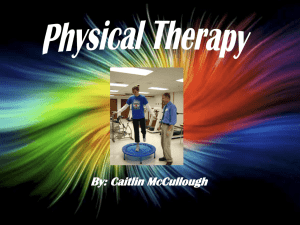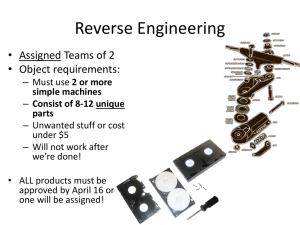
Scheele, J., Vijfvinkel, F., Rigter, M., Swinkels, I.C.S., Bierma-Zeinstra, S.M.A., Koes, B.W.,
Luijsterburg, P.A.J. Direct access to physical therapy for patients with low back pain in the
Netherlands: prevalence and predictors. Physical Therapy: 2014, 944(3), 363-70
Postprint
Version
Journal website
Pubmed link
DOI
1.0
http://ptjournal.apta.org/content/early/2013/12/18/ptj.20120330.long
http://www.ncbi.nlm.nih.gov/pubmed/?term=24092899
10.2522/ptj.20120330
This is a NIVEL certified Post Print, more info at http://www.nivel.eu
Direct Access to Physical Therapy for Patients
With Low Back Pain in the Netherlands:
Prevalence and Predictors
JANTINE SCHEELE, FRANK VIJFVINKEL, MARIJN RIGTER, ILSE C.S. SWINKELS, SITA M.A.
BIERMAN-ZEINSTRA, BART W. KOES, PIM A.J. LUIJSTERBURG
Background. In the Netherlands, direct access to physical therapy was
introduced in 2006. Although many patients with back pain visit physical
therapists through direct access, the frequency and characteristics of episodes of
care are unknown.
Objective. The purposes of this study were: (1) to investigate the prevalence of
direct access to physical therapy for patients with low back pain in the
Netherlands from 2006 to 2009, (2) to examine associations between mode of
access (direct versus referral) and patient characteristics, and (3) to describe the
severity of the back complaints at the beginning and end of treatment for direct
access and referral-based physical therapy.
Design. A cross-sectional study was conducted using registration data of
physical therapists obtained from a longitudinal study.
Method. Data were used from the National Information Service for Allied
Health Care, a registration network of Dutch physical therapists. Mode of access
(direct or referral) was registered for each episode of physical therapy care due
to back pain from 2006 to 2009. Logistic regression analysis was used to
explore associations between mode of access and patient/clinical characteristics.
Results. The percentage of episodes of care for which patients with back pain
directly accessed a physical therapist increased from 28.9% in 2006 to 52.1% in
2009. Characteristics associated with direct access were: middle or higher
education level (odds ratio [OR]=1.3 and 2.0, respectively), previous physical
therapy care (OR=1.7), recurrent back pain (OR=1.7), duration of back pain <7
days (OR=4.2), and age >55 years (OR=0.6).
Limitations. The study could not compare outcomes of physical therapy care by
mode of access because this information was not registered from the beginning
of data collection and, therefore, was missing for too many cases.
This is a NIVEL certified Post Print, more info at http://www.nivel.eu
Scheele, J., Vijfvinkel, F., Rigter, M., Swinkels, I.C.S., Bierma-Zeinstra, S.M.A., Koes, B.W.,
Luijsterburg, P.A.J. Direct access to physical therapy for patients with low back pain in the
Netherlands: prevalence and predictors. Physical Therapy: 2014, 944(3), 363-70
Conclusions. Direct access was used for an increasing percentage of episodes of
physical therapy care in the years 2006 to 2009. Patient/clinical characteristics
associated with the mode of access were education level, recurrent back pain,
previous physical therapy sessions, and age.
In 2006, a new health care system was introduced in the Netherlands.
The aims of this reform were to control the need for cost containment, to reduce
waiting lists, and to give patients more freedom of choice.1,2 Since 2006, all citizens
have been able to choose their own health insurance company, although basic
medical insurance is obligatory for the entire Dutch population, and formal referral
by the general practitioner (GP) or other medical doctor is no longer required to visit
a physical therapist. Advocates of direct access emphasize the freedom of choice for
patients, faster access to therapy, and lower health care costs.3 Opponents of direct
access are concerned that physical therapists might miss serious pathology, which
could lead to higher health care costs.3 In 2006, Leemrijse et al4 investigated the
number of patients using direct access and their characteristics.
They reported that the number of patients treated by physical therapists had not
increased during the year after the introduction of direct access compared with the
year before introduction. In the year after introduction, 28% of all patients directly
accessed a physical therapist.
Higher-educated patients aged <59 years used direct access more often, and patients
who reported having back or neck pain were more likely to use direct access for
physical therapy than patients with other symptoms.4 Patients with back pain are not
only more likely to use direct access, but in the Netherlands, back pain is also the
most commonly reported symptom by patients visiting a physical therapist.5 Because
this patient group is large, it is important for policy makers in the Netherlands, GPs,
and physical therapists to know which proportion of patients with back pain uses
direct access for physical therapy, any changes in proportion over the years, and the
characteristics of these patients. Information about the frequency of direct access use
and the influence of the patient and clinical characteristics also is important for
policy makers to consider in order to estimate future needs regarding direct access.
Therefore, the aims of this study were: (1) to investigate the prevalence of direct
access to physical therapy for patients with low back pain in the Netherlands from
2006 to 2009, (2) to examine associations between mode of access (direct versus
referral) and patient characteristics, and (3) to describe the severity of the back pain
at the beginning and end of treatment for direct access and referral-based physical
therapy.
METHOD
Data Source
The data used in this study originated from the National Information Service for
Allied Health Care (LiPZ).
LiPZ is a Dutch registration network of randomly selected physical therapists
working in private practice or physical therapists in all outpatient settings in the
Netherlands. This database is funded by the Dutch government.
This is a NIVEL certified Post Print, more info at http://www.nivel.eu
Scheele, J., Vijfvinkel, F., Rigter, M., Swinkels, I.C.S., Bierma-Zeinstra, S.M.A., Koes, B.W.,
Luijsterburg, P.A.J. Direct access to physical therapy for patients with low back pain in the
Netherlands: prevalence and predictors. Physical Therapy: 2014, 944(3), 363-70
The database holds longitudinal data collected on patients, referrals, diagnoses,
treatment, and evaluation in physical therapy care since 2001. Data were collected in
a representative network of about 100 physical therapists working in 40 practices.
Data on more than 10,000 patients were collected annually. At the start of LiPZ in
2001, a random sample, stratified for practice size and region, was drawn from the
Dutch register of physical therapists (including 16,000 therapists in 4,700 private
practices). Specialized physical therapists with a homogeneous patient population
(>50% of the treatment episodes belonging to 1 patient category), such as pediatric
physical therapists, were not included. The pool of participating practices fluctuates
from year to year. In the period 2001 to 2009, 156 physical therapists from 59
practices participated. Dropouts mostly occurred due to changing administration
software, quitting practice, or changes in available time. When dropouts occurred,
new physical therapists were recruited from new samples and through notes on the
websites of the software suppliers.
Annual checks were made for representation by size and region. When necessary,
attempts were made to recruit physical therapists in specific regions and with specific
characteristics in order to maintain representation.
Data were extracted monthly from the electronic medical records used in the physical
therapist practices in order to record their patients, treatments, and reimbursement.
Extracted data included data needed for reimbursement (eg, dates of treatments) and
supplementary information (eg, treatment goals). All treatment visits of all treated
patients were extracted. These data were entered in our research database after a
standardized quality control check for missing or inconsistent data. For this purpose,
software had been written by the administrator of the database.
In case of missing or inconsistent data, feedback was given to the practice concerned.
Physical therapists were asked to complement the missing data if applicable and if
possible.
In the subsequent monthly data supply, the complemented data were supposed to be
delivered. More detailed information about LiPZ and detailed information about
representation are available elsewhere.4,6
Sample
The study sample consisted of all episodes of care for patients with back pain who
visited a physical therapist (all physical therapists who participated in the LiPZ
network) in the period 2006 to 2009. This period was chosen because direct access to
the physical therapist became available in 2006 and relevant data were available until
2009. The health issues of all patients were classified in LiPZ according to the
International Classification of Primary Care (ICPC) codes.7,8 The following codes
were used to select patients with back pain: back symptoms and reports (L02),
reports of low back pain without radiation of pain (L03), fracture of the spine
(L76.06), osteoarthritis of the spine (L84), acquired deformities of the spine (L85),
and lumbar disk lesion or radiation of pain (L86). The ICPC codes of most referred
episodes were provided by the referrer. The ICPC codes of the direct access episodes
were provided by the research assistants, based on the patient’s description of the
main health problem, which is registered by the physical therapist.
A patient could have visited the physical therapist for several episodes of care in the
period 2006 to 2009. Because the mode of access might differ between different
This is a NIVEL certified Post Print, more info at http://www.nivel.eu
Scheele, J., Vijfvinkel, F., Rigter, M., Swinkels, I.C.S., Bierma-Zeinstra, S.M.A., Koes, B.W.,
Luijsterburg, P.A.J. Direct access to physical therapy for patients with low back pain in the
Netherlands: prevalence and predictors. Physical Therapy: 2014, 944(3), 363-70
episodes of care due to back pain reports for the same patient, each episode of care
was registered separately.
An episode of care was defined as care by a physical therapist due to back pain, from
the first consultation with the therapist to the end of treatment or absence of pain.
Measurements
The following data were collected for each episode of care due to back pain in the
period 2006 to 2009: mode of access (direct access or referral), age, sex, education
level, degree of urbanization of patients’ residence, diagnosis (based on the ICPC
code), recurrence of back pain, duration of back pain at start of treatment, severity of
back pain at the beginning of treatment, severity of back pain at the end of treatment,
and previous physical therapy sessions. The age categories (ie, 1–17, 18–34, 35–54,
55–74, and ≥75 years) were based on age boundaries that are commonly used in the
literature (18 years old is an age boundary in the Netherlands): children, young
adults, middle-aged adults, older adults, and elderly, respectively. The duration of the
health problem was based on acute or subacute back pain (<3 months), chronic back
pain (≥3 months), and back pain lasting > 1 year.
Direct access occurs when the patient visits the physical therapist without a referral
from a medical doctor. A referral occurs when the patient is referred by a medical
doctor (eg, GP, orthopedic surgeon, neurologist). Education level was divided into
lower education (primary school, lower vocational education, or lower secondary
education), middle education (intermediate vocational education or intermediate/
higher secondary education), and higher education (higher vocational education and
university).
Urbanization was divided into 5 categories (very strongly urbanized, strong,
moderate, little, and not urbanized), which was a measure of the concentration of
human activities according to classification of the Dutch Central Bureau of Statistics,
based on the average area density.
Patients were divided into the urbanization categories based on their postal code.
Severity of back pain was measured at the beginning and end of treatment on an 11point numerical rating scale (NRS), where 0 represents “no pain” and 10 represents
“the worst pain ever.”9 “Previous physical therapy” means that the patients had
received earlier physical therapy for a symptom (back pain or other symptom) in the
2 years preceding the present therapy. All variables were self-reported by the patients
except for mode of access, diagnosis, and urbanization.
Data Analysis
Descriptive statistics were used to calculate which percentage of episodes of care due
to back pain direct access or referral was used from 2006 to 2009. Multivariate
logistic regression analysis (method enter) was used to identify the associations
between mode of access and patient and clinical characteristics. Mode of access was
the dependent variable.
The patient characteristics (age, sex, education level, and degree of urbanization) and
clinical characteristics (duration of health problem before start of treatment,
recurrence of back pain, and previous therapy) were the independent variables
(categorical or dichotomous). For some patients, data were missing for urbanization,
duration of health problem, recurrence of back pain, earlier therapy sessions, and
This is a NIVEL certified Post Print, more info at http://www.nivel.eu
Scheele, J., Vijfvinkel, F., Rigter, M., Swinkels, I.C.S., Bierma-Zeinstra, S.M.A., Koes, B.W.,
Luijsterburg, P.A.J. Direct access to physical therapy for patients with low back pain in the
Netherlands: prevalence and predictors. Physical Therapy: 2014, 944(3), 363-70
education level. Because there were high percentages of missing values in the
variables “earlier therapy” (12.1%) and “education level” (23.5%) and to check
whether the missing data biased the results, we performed a multiple regression
analysis including dummy groups “unknown earlier therapy” and “unknown
education level.” The associations were presented as odds ratios (OR) with 95%
confidence intervals (95% CI). The associations between mode of access and patient
and clinical characteristics were adjusted for year of therapy, and adjusted odds ratio
(aOR) also was presented. Physical therapists did not always register all variables of
the episode, which led to missing values. The variables “severity of back pain at the
beginning of treatment” and “severity of back pain at the end of treatment” were not
included in the multivariate logistic regression analyses because these variables were
not registered from the beginning of data collection in 2006; therefore, information
was missing in many cases (>75%).
[TABLE 1.]
Bivariate logistic regression analysis was performed to explore the association
between severity of the back pain and mode of access. Covariations between the
independent variables and the year of therapy were measured using a covariance
matrix to check for correlation between the variables. Data were analyzed with IBM
SPSS Statistics for Windows, version 20.0 (IBM Corp, Armonk, New York).
Role of the Funding Source
Data from this study were acquired with funding from the Dutch Ministry of Health.
RESULTS
Characteristics of the Episodes of Care
Characteristics of the episodes of physical therapy care (grouped by mode of access)
for patients with back pain are presented in Table 1.
In total, 10,887 patients visited a physical therapist between 2006 and 2009, for
12,931 episodes of care. Of these episodes of care, the mode of access was known
for 12,018 episodes; 42.1% of the referred episodes of care were episodes of male
patients compared with 46.9% of the directly accessed episodes of care; and 56.6%
of the referred episodes of care and 57.6% of the direct accessed episodes of care
were from patients who had back pain for 1 week to 3 months before starting
treatment. The most frequently used ICPC code was “L03, low back complaints
without radiation of the pain”: this code applied to 44.1% of the referred and 54.8%
of the direct accessed episodes of care.
Direct Access or Referral
The Figure shows the distribution of episodes of care from the patients with back
pain for which direct access or referral was used from 2006 to 2009. In total, 7,077
(59%) episodes of care were registered via referral from a medical doctor and 4,941
(41%) episodes of care via direct access. The percentage of episodes of care due to
This is a NIVEL certified Post Print, more info at http://www.nivel.eu
Scheele, J., Vijfvinkel, F., Rigter, M., Swinkels, I.C.S., Bierma-Zeinstra, S.M.A., Koes, B.W.,
Luijsterburg, P.A.J. Direct access to physical therapy for patients with low back pain in the
Netherlands: prevalence and predictors. Physical Therapy: 2014, 944(3), 363-70
back pain for which direct access was used increased from 28.9% (973 episodes) in
2006 to 52.1% (1,544 episodes) in 2009.
[FIGURE 1]
Associations Between Patient or Clinical Characteristics and Mode of Access
Because no strong correlations were found among the variables (<.44), all 7
independent variables were included in the multiple logistic regression analysis. The
analysis was performed with the 2 dummy groups: “unknown earlier therapy” and
“unknown education level” (Tab. 2). Mode of access was associated with male sex
(OR=1.1, 95% CI=1.0 –1.2), age (OR=0.6, 95% CI=0.5– 0.8, for age category 55–74
years and OR=0.4, 95% CI=0.3– 0.6 for age category ≥ 75 years, compared with age
category 1–17 years), education level (OR=1.3, 95% CI=1.2–1.4, for middle
education level and OR=2.0, 95% CI=1.8 –2.3, for higher education level), duration
of the back pain (OR=4.2, 95% CI=3.6–4.9, for a duration of 7 days and OR=1.7,
95% CI=1.5–1.9, for a duration of 1 week to 3 months, compared with a duration of>
1 year), recurrent back pain (OR=1.7, 95% CI=1.6 –1.9), and previous physical
therapy (OR=1.7, 95% CI=1.5–1.9). When adjusted for year of therapy, the
associations remained the same (Tab. 2).
[TABLE 2]
Information on the severity of back pain was missing for many episodes of care
(>75%); therefore, explorative analyses were done to determine the associations
between mode of access and severity of the back pain. Data on severity of back pain
at the beginning of treatment were available for 2,211 episodes of physical therapy
care ( =7.0, SD =1.5, for episodes of care via referral; =6.6, SD=1.7, for
episodes of care via direct access) (OR=0.9, 95% CI=0.8–0.9). These findings
indicated that patients with more severe back pain at the beginning of treatment were
less likely to use direct access. Data on severity of back pain at the end of treatment
were available for 700 episodes of care ( = 3.0, SD = 2.3, for episodes of care via
referral; = 2.5, SD = 2.3, for episodes of care via direct access) (OR: 0.9; 95% CI:
0.8 –1.0).
DISCUSSION
This study (1) examined the prevalence of direct access to physical therapy for
patients with low back pain in the Netherlands from 2006 to 2009, (2) examined
associations between mode of access (direct versus referral) and patient
characteristics, and (3) described the severity of the back pain at the beginning and
end of treatment for direct access and referral-based physical therapy. The
percentage of episodes of care due to back pain for which patients directly accessed
the physical therapist increased substantially— from 28.9% in 2006 to 52.1% in
2009. The patient and clinical characteristics associated with direct access were male
sex, middle and higher education levels, previous physical therapy, recurrent back
pain, duration of back pain, and age.
This is a NIVEL certified Post Print, more info at http://www.nivel.eu
Scheele, J., Vijfvinkel, F., Rigter, M., Swinkels, I.C.S., Bierma-Zeinstra, S.M.A., Koes, B.W.,
Luijsterburg, P.A.J. Direct access to physical therapy for patients with low back pain in the
Netherlands: prevalence and predictors. Physical Therapy: 2014, 944(3), 363-70
Leemrijse et al4 performed a similar analysis with all patients (irrespective of their
symptoms) who visited a physical therapist during 2006.
They also compared patients who used direct access for their episode of care with
patients who were referred. Their results were comparable to those of our study.
Leemrijse et al4 concluded that patients with episodes of back pain were more likely
to use direct access than patients with other symptoms. Our results indicate that the
percentage of episodes of care for which direct access is used for visiting a physical
therapist had increased over the years. This finding could be due to the increasing
acquaintance with direct access or because patients who directly accessed the
physical therapist are more likely to use that mode again. Other studies comparing
the characteristics of referred and direct access patients in other countries reported
results similar to those of our study.10–13 The association between short duration of
the pain and direct access might be related to the amount of time involved in visiting
a GP or other medical doctor and being referred for therapy, implying that the back
pain may have been present for some time when these patients visit their physical
therapist for their episode of care. Patients with recurrent pain and those with
previous experience with physical therapy are probably more aware of the
possibilities and, therefore, more likely to directly access physical therapy for their
episode of care. The prevalence of back pain and other musculoskeletal disorders
increases with age,14 and older patients have more comorbidity for which they visit
their GP15,16 and probably find it easier to ask for a referral for physical therapy for
their back pain.
A limitation of the study was that it was not possible to investigate whether there was
an association between mode of access and treatment characteristics. Earlier studies
on direct access showed that patients who used direct access received fewer
treatment sessions. 4,12,13
Unfortunately, we had insufficient information on the number of treatment sessions
to confirm or refute the earlier findings. Information on the severity of the back pain
was missing for many episodes (75%); therefore, we performed only explorative
analyses, which showed small associations between mode of access and severity of
the back pain. Future research will examine the impact of direct access compared
with referral on severity of the pain.
Another limitation was a lack of information on the diagnosis of the back pain. Some
information on the diagnosis could be obtained from the ICPC code; however, in this
study, the ICPC code of most referred patients was provided by the referrer, and the
ICPC codes of the direct access patients were provided by the researcher. Because of
this methodological difference, the associations between ICPC code and mode of
access were not analyzed. The lower percentage of specific causes of back pain
(ICPC codes L76.06: fracture of the spine, L84: osteoarthritis of the spine, and L85:
acquired deformities of the spine) in the direct access groups could indicate a
negative association with direct access, or it could be due to the different methods
used to assign an ICPC code.
In summary, in the present study, direct access for physical therapy episodes of care
due to back pain increased from 28.9% in 2006 to 52.1% in 2009. There was an
association between mode of access and several patient and clinical characteristics.
Physical therapists should be aware that the number of episodes of care due to back
pain via direct access substantially increased over the years. Policy makers should be
aware of the increased percentage of episodes of care for which direct access was
This is a NIVEL certified Post Print, more info at http://www.nivel.eu
Scheele, J., Vijfvinkel, F., Rigter, M., Swinkels, I.C.S., Bierma-Zeinstra, S.M.A., Koes, B.W.,
Luijsterburg, P.A.J. Direct access to physical therapy for patients with low back pain in the
Netherlands: prevalence and predictors. Physical Therapy: 2014, 944(3), 363-70
used. Further research should evaluate whether treatment management and outcomes
also are influenced by the mode of access.
Dr Scheele, Dr Rigter, Dr Bierman-Zeinstra, Dr Koes, and Dr Luijsterburg provided concept/
idea/research design. Dr Scheele, Dr Vijfvinkel, Dr Rigter, Dr Bierman-Zeinstra, Dr Koes,
and Dr Luijsterburg provided writing.
Dr Swinkels provided data collection and fund procurement. Dr Scheele, Dr Vijfvinkel, Dr
Rigter, Dr Bierman-Zeinstra, and Dr Luijsterburg provided data analysis. Dr Swinkels, Dr
Bierman-Zeinstra, Dr Koes, and Dr Luijsterburg provided project management.
Dr Luijsterburg provided facilities/equipment.
Dr Swinkels, Dr Koes, and Dr Luijsterburg provided consultation (including review of
manuscript before submission).
Data from this study were acquired with funding of the Dutch Ministry of Health.
DOI: 10.2522/ptj.20120330
REFERENCES
1 Knottnerus JA, ten Velden GH. Dutch doctors and their patients: effects of health care
reform in the Netherlands. N Engl. J Med. 2007;357:2424–2426.
2 Schafer W, Kroneman M, Boerma W, et al. The Netherlands: health system review. Health
Syst Transit. 2010;12:v-xxvii, 1–228.
3 Crout KL, Tweedie JH, Miller DJ. Physical therapists’ opinions and practices regarding
direct access. Phys Ther. 1998;78:52– 61.
4 Leemrijse CJ, Swinkels IC, Veenhof C. Direct access to physical therapy in the
Netherlands: results from the first year in community-based physical therapy. Phys Ther.
2008;88:936–946.
5 Verheij RA, van Dijk CE, Abrahamse H, et al. Landelijk Informatie Netwerk Huisartsenzorg
(LINH) Kerncijfers 2008. Utrecht, the Netherlands: Netherlands Institute for Health Services
Research (NIVEL); 2010.
6 Kooijman MK, Swinkels IC, Leemrijse CJ, et al. Landelijke Informatievoorziening
Paramedische Zorg. Utrecht, the Netherlands: Netherlands Institute for Health Services
Research (NIVEL). Available at: http://nivel.nl/lipz. Accessed January 17, 2012.
7 Hofmans-Okkes IM, Lamberts H. The International Classification of Primary Care (ICPC):
new applications in research and computer-based patient records in family practice. Fam
Pract. 1996;13:294–302.
8 Lamberts H, Wood M. The birth of the International Classification of Primary Care (ICPC):
serendipity at the border of Lac Leman. Fam Pract. 2002;19:433–435.
9 Von Korff M, Jensen MP, Karoly P. Assessing global pain severity by self-report in clinical
and health services research. Spine. 2000;25:3140–3151.
10 Holdsworth LK, Webster VS. Direct access to physiotherapy in primary care: now? and
into the future? Phys Ther. 2004;90: 64–72.
11 Holdsworth LK, Webster VS, McFadyen AK. Are patients who refer themselves to
physiotherapy different from those referred by GPs? Results of a national trial. Phys Ther.
2006;92:26 –33.
12 Mitchell JM, de Lissovoy G. A comparison of resource use and cost in direct access
versus physician referral episodes of physical therapy. Phys Ther. 1997;77:10 –18.
13 Pendergast J, Kliethermes SA, Freburger JK, Duffy PA. A comparison of health care use
for physician-referred and self-referred episodes of outpatient physical therapy. Health
Serv Res. 2012;47:633–654.
14 Jordan KP, Kadam UT, Hayward R, et al. Annual consultation prevalence of regional
musculoskeletal problems in primary care: an observational study. BMC Musculoskelet
Disord. 2010;11:144.
15 van Baal PH, Engelfriet PM, Boshuizen HC, et al. Co-occurrence of diabetes, myocardial
infarction, stroke, and cancer: quantifying age patterns in the Dutch population using health
survey data. Popul Health Metr. 2011;9:51.
This is a NIVEL certified Post Print, more info at http://www.nivel.eu
Scheele, J., Vijfvinkel, F., Rigter, M., Swinkels, I.C.S., Bierma-Zeinstra, S.M.A., Koes, B.W.,
Luijsterburg, P.A.J. Direct access to physical therapy for patients with low back pain in the
Netherlands: prevalence and predictors. Physical Therapy: 2014, 944(3), 363-70
16 Westert GP, Satariano WA, Schellevis FG, van den Bos GA. Patterns of comorbidity and
the use of health services in the Dutch population. Eur J Public Health. 2001;11: 365–372.
TABLES AND FIGURE
This is a NIVEL certified Post Print, more info at http://www.nivel.eu
Scheele, J., Vijfvinkel, F., Rigter, M., Swinkels, I.C.S., Bierma-Zeinstra, S.M.A., Koes, B.W.,
Luijsterburg, P.A.J. Direct access to physical therapy for patients with low back pain in the
Netherlands: prevalence and predictors. Physical Therapy: 2014, 944(3), 363-70
Figure. Percentage of episodes of physical therapy care (N=12,018) for which patients with
back pain used direct access or were referred (2006–2009).
This is a NIVEL certified Post Print, more info at http://www.nivel.eu
Scheele, J., Vijfvinkel, F., Rigter, M., Swinkels, I.C.S., Bierma-Zeinstra, S.M.A., Koes, B.W.,
Luijsterburg, P.A.J. Direct access to physical therapy for patients with low back pain in the
Netherlands: prevalence and predictors. Physical Therapy: 2014, 944(3), 363-70
This is a NIVEL certified Post Print, more info at http://www.nivel.eu








